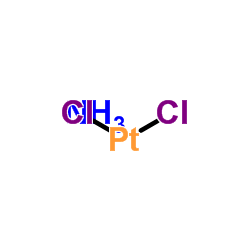trans-Dichlorodiamineplatinum(II)

trans-Dichlorodiamineplatinum(II) structure
|
Common Name | trans-Dichlorodiamineplatinum(II) | ||
|---|---|---|---|---|
| CAS Number | 14913-33-8 | Molecular Weight | 300.051 | |
| Density | 3.746 g/cm3 | Boiling Point | N/A | |
| Molecular Formula | H6Cl2N2Pt | Melting Point | 340ºC (dec.) | |
| MSDS | Chinese USA | Flash Point | N/A | |
| Symbol |


GHS05, GHS08 |
Signal Word | Danger | |
|
TAp73 promotes cell survival upon genotoxic stress by inhibiting p53 activity.
Oncotarget 5(18) , 8107-22, (2014) p53 plays a key role in regulating DNA damage response by suppressing cell cycle progression or inducing apoptosis depending on extent of DNA damage. However, it is not clear why mild genotoxic stress favors growth arrest, whereas excessive lesions signal cel... |
|
|
Combination of systemic chemotherapy with local stem cell delivered S-TRAIL in resected brain tumors.
Stem Cells 33(1) , 101-10, (2014) Despite advances in standard therapies, the survival of glioblastoma multiforme (GBM) patients has not improved. Limitations to successful translation of new therapies include poor delivery of systemic therapies and use of simplified preclinical models which ... |
|
|
Crystals of Na(+)/K(+)-ATPase with bound cisplatin.
Biochem. Pharmacol. 92(3) , 494-8, (2014) Cisplatin is the most widely used chemotherapeutics for cancer treatment, however, its administration is connected to inevitable adverse effects. Previous studies suggested that cisplatin is able to inhibit Na(+)/K(+)-ATPase (NKA), the enzyme responsible for ... |
|
|
Glutathione S-transferase P1 (GSTP1) directly influences platinum drug chemosensitivity in ovarian tumour cell lines.
Br. J. Cancer 111(6) , 1150-8, (2014) Chemotherapy response in ovarian cancer patients is frequently compromised by drug resistance, possibly due to altered drug metabolism. Platinum drugs are metabolised by glutathione S-transferase P1 (GSTP1), which is abundantly, but variably expressed in ovar... |
|
|
Epstein-Barr virus nuclear antigen 3A protein regulates CDKN2B transcription via interaction with MIZ-1.
Nucleic Acids Res. 42(15) , 9700-16, (2014) The Epstein-Barr virus (EBV) nuclear antigen 3 family of protein is critical for the EBV-induced primary B-cell growth transformation process. Using a yeast two-hybrid screen we identified 22 novel cellular partners of the EBNA3s. Most importantly, among the ... |
|
|
Cisplatin at sub-toxic levels mediates integrin switch in lung cancer cells.
Anticancer Res. 34(12) , 7111-7, (2014) Resistance to chemotherapeutic agents, as well as enhanced metastasis, have been frequently reported in lung cancer.Cytotoxicity and proliferative effects of cisplatin on H460 lung cancer cells were evaluated by the MTT assay. Migration capacity was evaluated... |
|
|
Nucleolar targeting by platinum: p53-independent apoptosis follows rRNA inhibition, cell-cycle arrest, and DNA compaction.
Mol. Pharm. 12(1) , 287-97, (2015) TriplatinNC is a highly positively charged, substitution-inert derivative of the phase II clinical anticancer drug, BBR3464. Such substitution-inert complexes form a distinct subset of polynuclear platinum complexes (PPCs) interacting with DNA and other biomo... |
|
|
Direct chemosensitivity monitoring ex vivo on undissociated melanoma tumor tissue by impedance spectroscopy.
Cancer Res. 74(22) , 6408-18, (2014) Stage III/IV melanoma remains incurable in most cases due to chemotherapeutic resistance. Thus, predicting and monitoring chemotherapeutic responses in this setting offer great interest. To overcome limitations of existing assays in evaluating the chemosensit... |
|
|
Enhanced expression of DNA polymerase eta contributes to cisplatin resistance of ovarian cancer stem cells.
Proc. Natl. Acad. Sci. U. S. A. 112(14) , 4411-6, (2015) Cancer stem cells (CSCs) with enhanced tumorigenicity and chemoresistance are believed to be responsible for treatment failure and tumor relapse in ovarian cancer patients. However, it is still unclear how CSCs survive DNA-damaging agent treatment. Here, we r... |
|
|
SMURF1 silencing diminishes a CD44-high cancer stem cell-like population in head and neck squamous cell carcinoma.
Mol. Cancer 13 , 260, (2014) Bone morphogenetic protein (BMP) signaling is thought to play key roles in regulating the survival and maintenance of cancer stem cells (CSCs), which contribute to disease recurrences and treatment failures in many malignances, including head and neck squamou... |